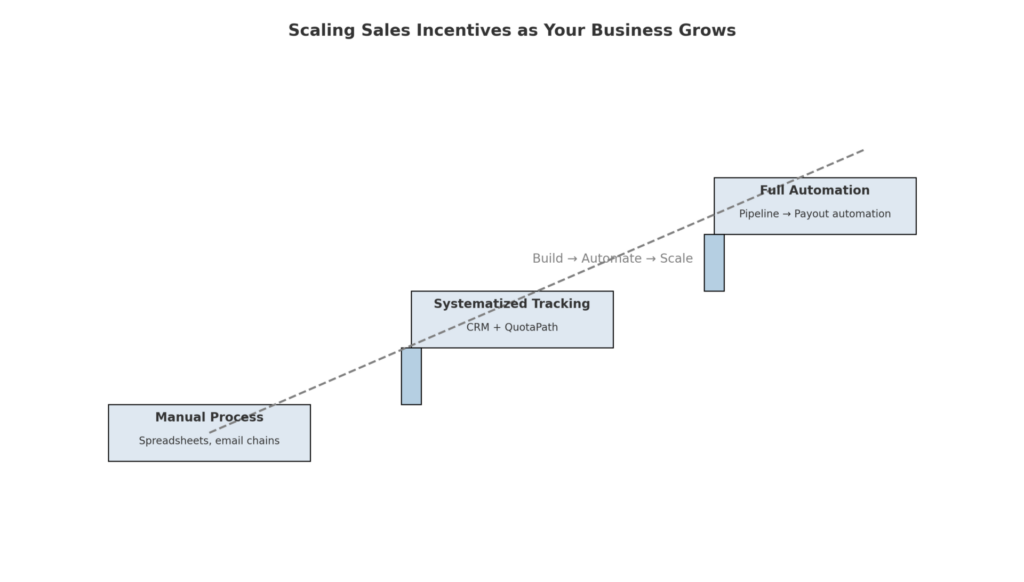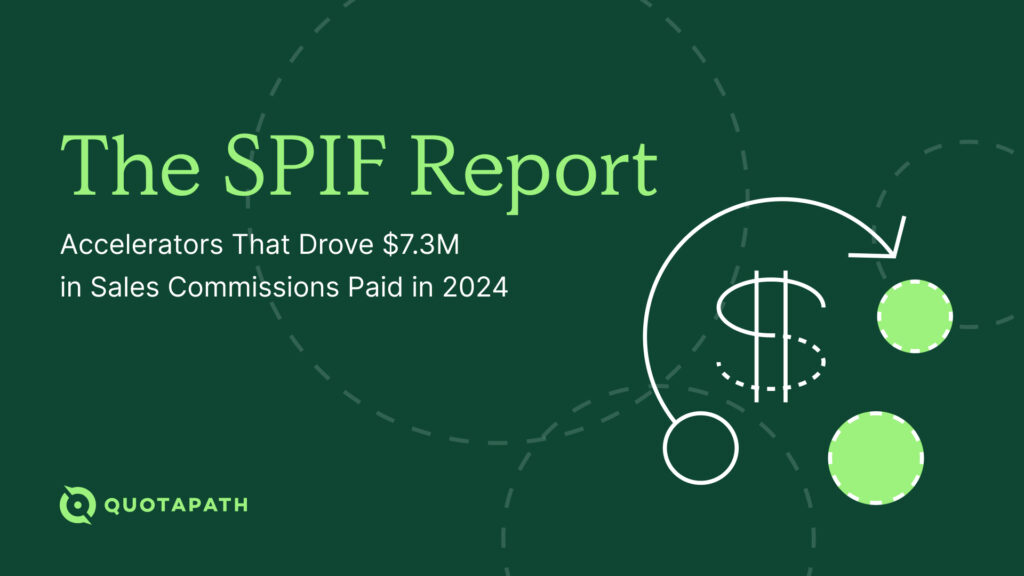Sales compensation planning is one of the most effective levers for driving aligned revenue growth.
However, many teams still rely on outdated or ad hoc plans, leading to confusion, misalignment, and rep churn. According to our research, 39% of companies report that their compensation plans don’t align with company goals.
A strong comp plan can be a competitive edge in attracting sales talent and supporting scaling sales incentives as the team grows. It also shapes behavior and supports performance that drives the achievement of organizational goals.
This guide outlines how businesses can design smart, scalable sales compensation plans to motivate reps and drive revenue growth.

Understanding Sales Compensation
Understanding compensation planning and its objectives will help you create a more effective sales compensation plan.
Sales compensation planning is the strategic process of designing, implementing, and evolving compensation plans to align sales activity with business growth goals. Comp plans serve two core functions: motivating seller behavior and controlling cost of sale.
A good sales comp plan can do more than pay reps: it can help founders and operators identify scalable, intentional selling motions. For example, a comp plan rewarding longer-term contracts or multi-product deals can directly support strategic goals around runway and sales compensation.
According to Sangram Vajre and Lindsay Cordell in HBR, “too many companies still oversimplify by assigning quotas and commissions based solely on what segment (enterprise, mid-market, SMB) a seller is pitching. This traditional approach results in overpaying some salespeople and underpaying others, without accounting for two key factors.”
These factors include which go-to-market (GTM) tactics you are using, and where your company is in its business evolution. They continued by stating, “most B2B companies should revisit sales compensation at least once a year no matter what.”
Using Equity vs Compensation Structures
As your business builds out its compensation strategy, it’s important to consider not only how much to pay but also how to pay. Balancing cash compensation and equity can help you stay competitive in the talent market while aligning incentives with both short—and long-term goals.
Equity-based compensation can be a strategic tool for startups and small businesses to attract top sales talent when cash flow is limited. Offering equity aligns sales reps’ interests with the company’s long-term success, fostering a sense of ownership and commitment.
Cash compensation provides immediate rewards and is often preferred by sales professionals prioritizing short-term earnings. Balancing equity and cash ensures competitiveness in the market while managing financial constraints. According to HubSpot, smaller companies (fewer than 10 employees) often offer equity stakes ranging from 0.5% to 1% to attract talent.
When to Offer Equity to Sales Reps
Early-stage startups may offer equity to compensate for lower salaries and to incentivize early employees to contribute to the company’s growth. Equity is particularly effective for roles that significantly impact the company’s trajectory, such as sales leaders or high-performing sales reps. The Follow Up suggests that sales reps at seed-stage startups might receive approximately 1-3% equity, while those at Series A stages receive smaller percentages.
Implementing vesting schedules, typically over four years with a one-year cliff, is crucial to ensuring long-term commitment. Holloway’s guide emphasizes the importance of structuring equity plans with clear vesting terms to align employee incentives with company goals.
Designing Your Business’s Sales Compensation Structure
Creating a strong compensation structure means choosing the right components for your business stage, team roles, and revenue model. Each element plays a key role in shaping rep behavior and driving performance, from base salary to commission rates to payout frequency.
| Component | What It Is | Tips for Small Businesses |
| Base Salary vs. Commission Mix | The balance between guaranteed pay and performance-based earnings | For startup sales teams, consider a 50/50 or 60/40 split to offer some stability with strong performance upside |
| Quota Setting | Target revenue or activity goals for a rep to achieve | Set realistic quotas based on historical data, rep experience, and funding stage |
| Commission Rates | The percentage a rep earns on closed deals | Use tiered rates to encourage over-performance (e.g., 5% up to quota, 8% beyond quota) |
| Accelerators & Milestones | Bonus rates or flat bonuses for exceeding targets or hitting key milestones | Reward high performers with accelerators (e.g., multi-product deals or long-term contracts) |
| Plan by Role Type | Tailored comp plans for different sales roles (AE, SDR, AM, etc.) | SDRs may benefit from activity-based incentives; AEs from deal value commissions |
| Equity Considerations | Offering company stock or options as part of the comp package | In early-stage businesses, equity for sales can compensate for lower base pay |
| SPIFs (Short-Term Incentives) | One-off bonuses for specific behaviors or deal types | Use SPIFs to drive specific outcomes (e.g., closing a feature launch deal, upselling during a slow month) |
| Payout Frequency & Eligibility | How often reps are paid and what conditions must be met | Monthly or quarterly payouts; align eligibility with payment received or customer onboarding |
Incentive Structures for Sales Teams
Not all commission structures are created equal—businesses must tailor plans to team roles, company stage, and growth goals. Clear, motivating incentives that are easy to understand and directly linked to outcomes that the business cares about are essential when creating incentive programs.
Account Executive (AE) Incentive Structures
Typically, quota-carrying roles responsible for closing new business, upsells, or renewals:
- Use tiered commission rates (e.g., 5% up to quota, 8% beyond quota) to reward overperformance
- Add accelerators for multi-year deals, multi-product sales, or self-sourced pipeline
- Include SPIFs for strategic initiatives (e.g., new product launches or new logo wins)
- AEs at early-stage companies may benefit from equity for sales to make up for leaner base pay
For compensation plan templates for account executives, check out our library: QuotaPath AE Comp Plan Templates.
RevOps, sales leaders, and finance teams use our free tool to ensure reps’ on-target earnings and quotas line up with industry standards. Customize plans with accelerators, bonuses, and more, by adjusting 9 variables.
Build a Comp PlanSDR Incentive Structures
Meanwhile, SDRs are most commonly compensated on meetings booked, qualified opportunities, or pipeline sourced
- Incentives can be tied to:
- Number of demos scheduled
- % of demos that convert to opportunities
- Total pipeline generated
You can also use a points-based system or flat bonus per qualified lead for clarity.
Consider monthly SPIFs for team contests or time-bound pushes. For instance, a SPIF like “book 10 demos by EOM” helps drive high activity volume while aligning SDRs with broader GTM success. These short-term incentives boost morale, create a sense of urgency, and reinforce key behaviors that support pipeline growth.
When used strategically, SPIFs complement your core compensation plan by giving teams focused, achievable goals contributing to larger revenue outcomes. For compensation plan templates for SDRs, check out our library: SDR Comp Plan Templates
Common Challenges in Sales Compensation
Below are some of the more common challenges. However, many small organizations and startups don’t have historical data from which to build new comp plans, leaving them with a lot of guesswork. That’s why starting with a simple basic plan to get started is necessary with the ability to adjust plans mid-year as you learn more about average sales price, sales cycle length, and closed/win ratios.
Liz Christo suggests, “I’d pull back to a quarterly quota. This allows you to mimic building an annual plan but gives you the flexibility to set appropriate quotas as you see changes in your sales cycles. It also sets everyone up for success, knowing they aren’t signing on for a plan that is daunting and too far away.”
Managing Compensation on a Tight Budget
To effectively manage compensation with a limited budget, offer performance-based incentives, then focus on non-monetary rewards, recognition, and desirable benefits. This approach can help maintain employee motivation and satisfaction without exceeding budget constraints.
Aligning Incentives with Company Goals
Even well-structured incentive programs will fail if they aren’t aligned with business objectives. Start by clearly defining company goals and identifying sales rep behaviors that support these goals. Then, incentivize those behaviors to drive business objective achievement.
Preventing Sales Team Burnout
To prevent sales team burnout, focus on compensation transparency, clear paths to sales quotas, and a balance between rewards and recognition. Provide teams with an application, like QuotaPath, for visibility into progress toward compensation milestones that help prioritize deals that will push them over the mark. Consider providing flexible compensation options and mental health resources, and fostering a culture that values work-life balance.

Scaling Sales Incentives as Your Business Grows
As your team and revenue goals evolve, your sales compensation plan should grow with them. Building in scalability from the start allows you to adapt quickly, align incentives with your sales strategy, and support sustainable performance across the entire sales organization.
- Start simple, scale with structure: Avoid overengineering early on. Begin with a clear, easy-to-administer plan and layer in complexity as your team and revenue model evolve.
- Tie incentives to evolving GTM priorities: As your go-to-market motion shifts, ensure comp plans evolve to reinforce the right behaviors and outcomes.
- Adjust based on team maturity and data quality: More mature teams and better data allow for more nuanced plans and sales performance metrics.
- Introduce leadership or manager plans: Motivate leadership by aligning their incentives with coaching effectiveness, team attainment, and strategic execution.
- Incorporate team and multi-level quota rollups: Enable collaboration and accountability by tying manager and rep incentives to team targets.
- Create plan flexibility to accommodate different sales motions: Customize incentives for roles focused on new business, expansion, renewals, or channel sales.
- Monitor payout consistency and ROI: Regularly review how incentive spend aligns with performance outcomes to ensure the plan delivers value.
- Build equity refresh cycles for long-tenured sellers: Offer long-term incentives beyond the initial grant to keep top performers invested.
- Document everything: Outline plan mechanics, policies, and exceptions clearly in a centralized location to avoid confusion and misalignment.
Tech Stack for Sales Teams
The right tools help small businesses scale efficiently, improve visibility, and reduce manual errors. The tech stack should support both revenue generation and compensation transparency.
For example, this list of key tech stack elements meets this criteria:
- Customer Relationship Management (CRM) (HubSpot)
- Compensation Management (QuotaPath)
- Sales Engagement Tools (Outreach)
- Communication & Collaboration Tools (Slack)
- Reporting & Forecasting Tools (Anaplan)
- Payroll & HRIS Systems (Rippling)
Design, track, and manage variable incentives with QuotaPath. Give your RevOps, finance, and sales teams transparency into sales compensation.
Talk to SalesFinal Thoughts
Sales compensation planning is one of the most powerful levers for driving aligned revenue growth. However, many businesses rely on outdated, inconsistent approaches that create confusion, misalignment, and rep turnover. A well-designed commission structure garners employee motivation while reinforcing the behaviors that drive business objective achievement.
As your company grows, your compensation strategy must evolve alongside it. Building plans that scale, support your go-to-market goals, and attract top talent sets you up for long-term success.Work with QuotaPath on your sales compensation plans.





